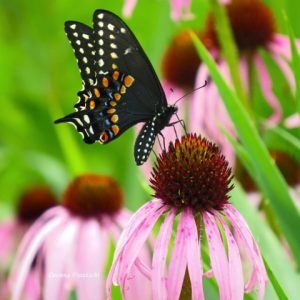Two important gardening tasks for autumn
Chronicle Media — October 22, 2016
Some butterflies overwinter in the chrysalis (Black Swallowtail) or as an adult (Eastern Comma) in plant debris and leaves.
University of Illinois Extension Horticulture Educator Kelly Allsup recommends two essential gardening tasks to do this fall: fertilize your trees and refrain from cleaning up your perennial garden.
Fall is a great time to fertilize trees; roots remain active in absorbing nutrients and water despite the leaves falling off of the tree. Fertilizing trees is a great way to reduce the environmental stresses of the growing season.
If your tree is showing nutrient deficiencies such as yellowing leaves and growing less than two to four inches a year, or you have not fertilized the lawn underneath the tree, fertilizer treatments may bring benefits to your tree.
If you look at a branch, you can see the past year’s terminal bud scar. It is a scar that completely encircles the branch like a wrinkle. Measure from the old terminal bud to the new terminal bud and the measurement will show how much your tree grew this year.
If you decide to fertilize, use a fertilizer with a nitrogen level (the first number on the bag) of 10 percent. You can broadcast fertilizer if there is no grass at the base of the tree. Otherwise, use tree feeding spikes or create holes 18-inches deep and 2 feet apart and pour in liquid fertilizer. Continue this process 1.5 times as wide as the canopy of the tree.
According to Morton Arboretum, the rate is two to three pounds of 12 to 30 percent nitrogen and 3 to 12 percent potassium per inch of diameter of the tree at waist height. If the distance around the trunk is 18 or more inches in diameter, then you would apply 36 to 54 pounds of fertilizer.
Gardeners have been taught for years to clean up their gardens and leave them barren for the winter. However, gardeners were not thinking about creating a winter habitat of old plants and leaf piles for wildlife.
Bees overwinter in bark crevices and underground burrows that are not laden with piles of mulch. Some butterflies overwinter in the chrysalis (Black Swallowtail) or as an adult (Eastern Comma) in plant debris and leaves. Some caterpillars overwinter in rolled up leaves (Red Spotted Purple) or seed pods.
Native ladybugs overwinter in piles of leaves or under rocks. Birds use winter gardens as a source of food in the form of seed heads to sustain themselves throughout the winter; the garden also supplies cover from the elements. Goldfinches are commonly spotted around timeworn coneflowers. Spent garden materials offer winter protection for toads and salamanders.
Wait to cut perennials back; in the spring, cut them to 12 inches and let the new growth grow up around the old stems. The skeleton of the winter garden will protect perennials and annual seeds from the harsh environment of our Illinois winters. The only exception to removing foliage before winter would be if it is showing signs of disease.
— Two important gardening tasks for autumn —







